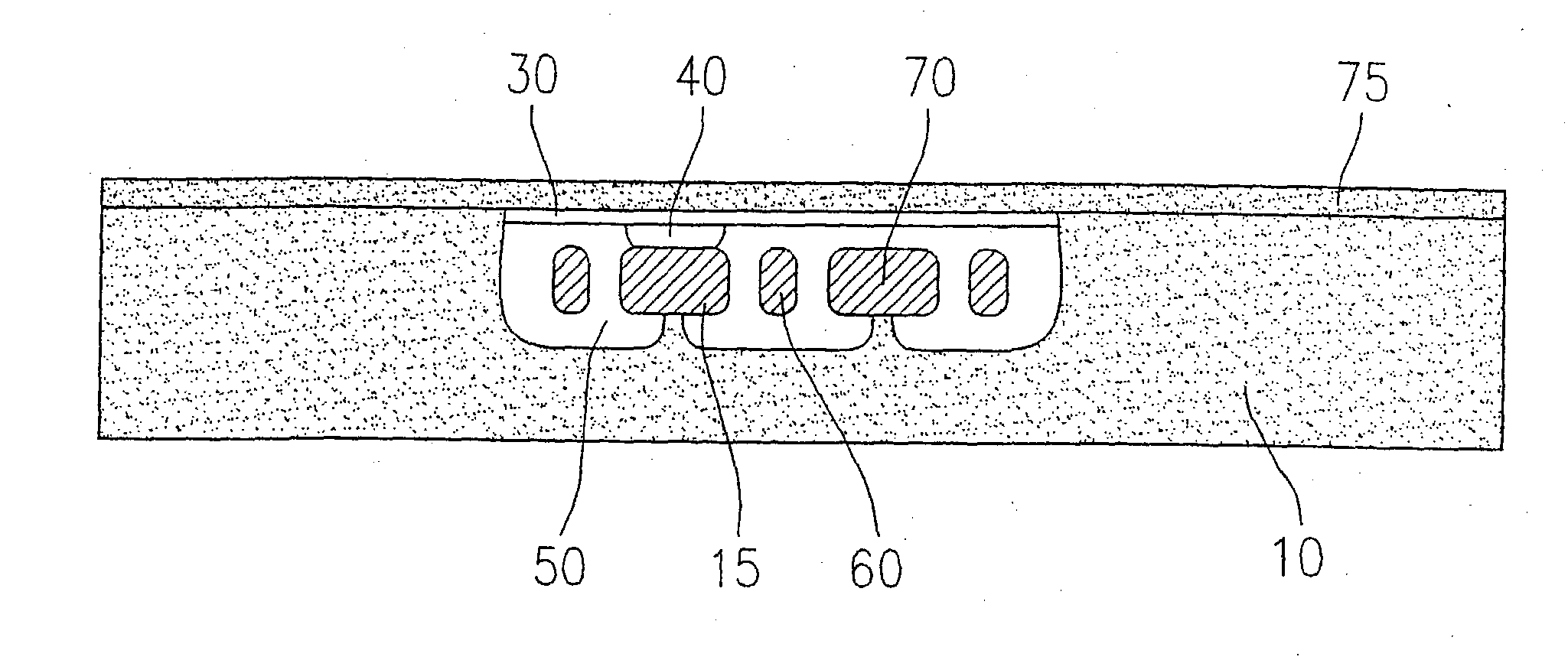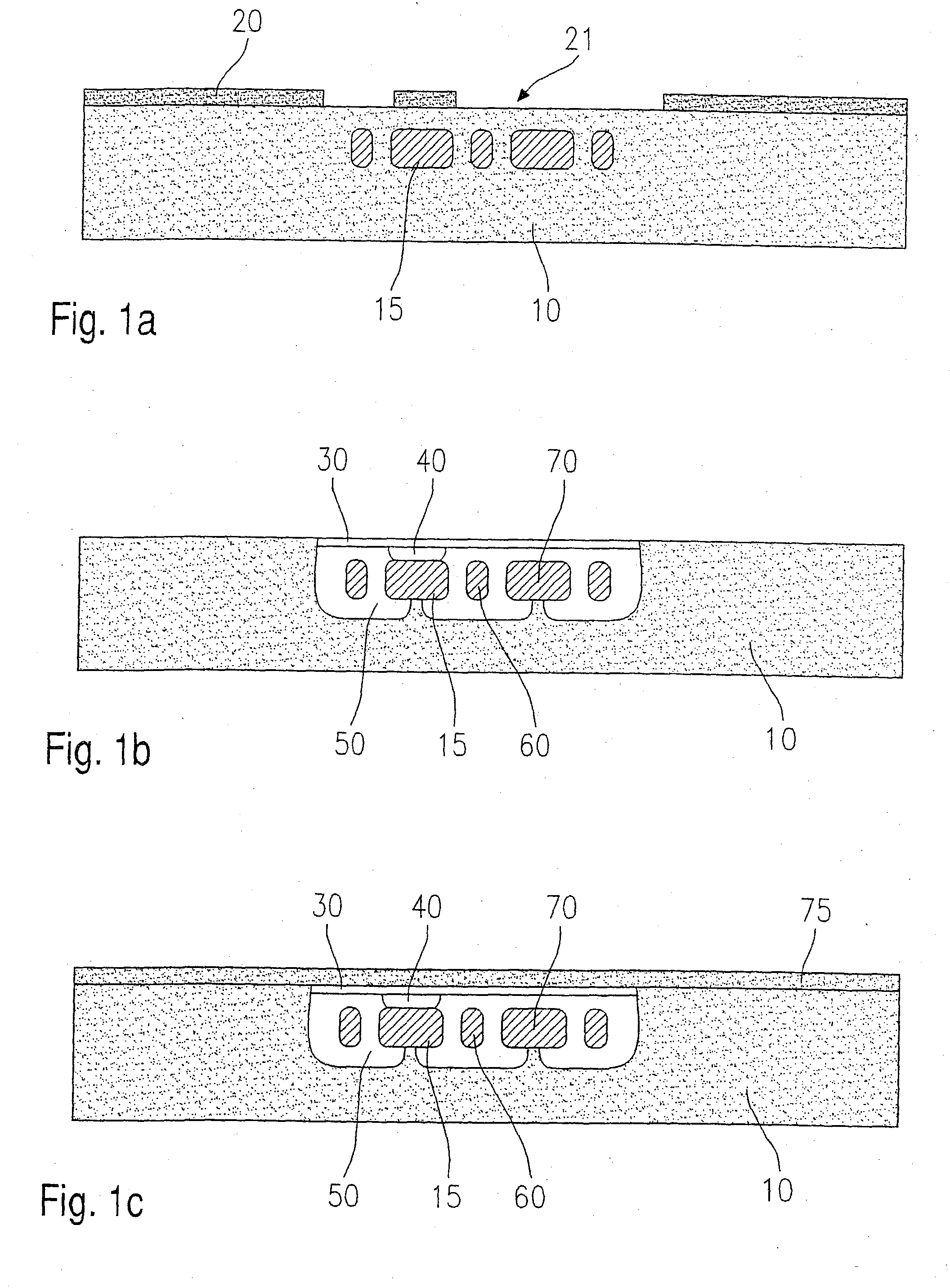Micromechanical component and corresponing production method
a micromechanical and production method technology, applied in microstructural devices, microstructured technology, fluid pressure measurement, etc., can solve the problems of increased handling and packaging costs, large share of the cost of manufacturing an acceleration sensor by surface micromachining, and increased costs
- Summary
- Abstract
- Description
- Claims
- Application Information
AI Technical Summary
Problems solved by technology
Method used
Image
Examples
first embodiment
[0063] FIGS. 5a,b schematically show a micromechanical component according to the present invention, specifically a cross-sectional view in FIG. 5a and a top view in FIG. 5b.
[0064] FIGS. 5a, b illustrate a use as a branched flow channel having defined transfer openings. In this embodiment the transfer openings are provided as back openings 510, while porous zone 30 is hermetically sealed by a sealing layer 75.
[0065] N-doped zones 15 are used to define the lower limit of cavity 50a and thus the bottom of the flow channel. It is possible to attain the Y-shaped structure of the flow channel by suitable masking.
[0066] In particular, transfer openings 520 are provided in the structure shown in FIGS. 5a, b, which are provided in n-doped zone 15 so that when back openings 510 are etched from the back, the passages do not become too large, which is indicated by the corresponding bell-shaped back etching profile. In this respect, n-doped zone 15 also acts as an etching stop for the etching f...
second embodiment
[0068] FIGS. 6a,b schematically show a micromechanical component according to the present invention, specifically a cross-sectional view in FIG. 6a and a top view in FIG. 6b.
[0069] The structure shown in FIG. 6a is a refinement of the structure shown in FIGS. 5a, b. In this case, piezoresistive resistors 630, 630' are provided on the sealing layer above porous zone 30. Varying flow rates in flow direction FD result in a varying pressure which subjects the diaphragm and thus piezoresistive resistors 630, 630' to a voltage of varying strength. The resulting change in resistance may be analyzed. It is also possible to use a heating structure having temperature sensors analogous to the previous thermal mass flow sensors.
[0070] It is advantageous in this connection that due to the supply of the mass flow from the back, it is not necessary to protect resistance elements 630, 630' against media.
third embodiment
[0071] FIGS. 7a,b show a schematic view in cross-section of a micromechanical component according to the present invention, specifically a micro-sealing ball in FIG. 7a and a micro-sealing plate in FIG. 7b.
[0072] The embodiment shown in FIGS. 7a, b relates to a check valve. In this case, 730 denotes a micro-sealing ball in FIG. 7a and 740 denotes a micro-sealing plate in FIG. 7b, which together with transfer opening 720 in n-doped zone 15b form a check valve. Micro-sealing ball 730 and / or micro-sealing plate 740 are formed simultaneously with the flow channel and / or transfer opening 720 during the anodization process and seal off transfer opening 720 in the event of a return flow.
PUM
| Property | Measurement | Unit |
|---|---|---|
| Flow rate | aaaaa | aaaaa |
| Structure | aaaaa | aaaaa |
| Depth | aaaaa | aaaaa |
Abstract
Description
Claims
Application Information
 Login to View More
Login to View More - R&D
- Intellectual Property
- Life Sciences
- Materials
- Tech Scout
- Unparalleled Data Quality
- Higher Quality Content
- 60% Fewer Hallucinations
Browse by: Latest US Patents, China's latest patents, Technical Efficacy Thesaurus, Application Domain, Technology Topic, Popular Technical Reports.
© 2025 PatSnap. All rights reserved.Legal|Privacy policy|Modern Slavery Act Transparency Statement|Sitemap|About US| Contact US: help@patsnap.com



